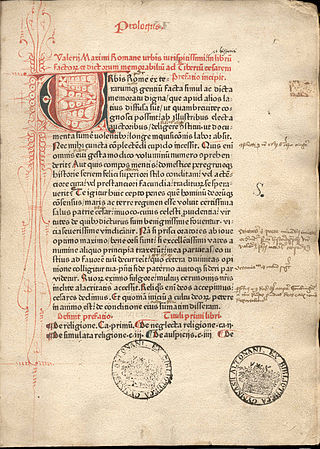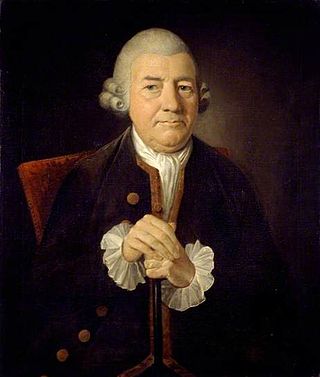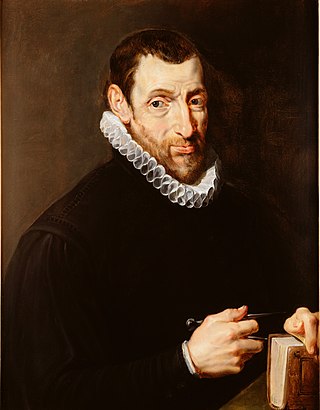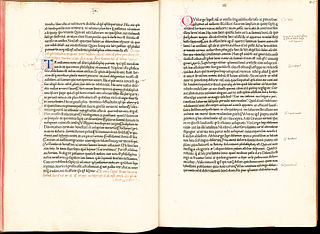Related Research Articles

An incunable or incunabulum is a book, pamphlet, or broadside that was printed in the earliest stages of printing in Europe, up to the year 1500. Incunabula were produced before the printing press became widespread on the continent and are distinct from manuscripts, which are documents written by hand. Some authorities on the history of printing include block books from the same time period as incunabula, whereas others limit the term to works printed using movable type.

John Baskerville was an English businessman, in areas including japanning and papier-mâché, but he is best remembered as a printer and type designer. He was also responsible for inventing "wove paper", which was considerably smoother than "laid paper", allowing for sharper printing results.

Thomas Hearne or Hearn was an English diarist and prolific antiquary, particularly remembered for his published editions of many medieval English chronicles and other important historical texts.
This article is a list of the literary events and publications in the 15th century.
John Rastell was an English printer, author, member of parliament, and barrister.

Joseph Ames was an English bibliographer and antiquary. He purportedly wrote an account of printing in England from 1471 to 1600 entitled Typographical Antiquities (1749). It is uncertain whether he was by occupation a ship's chandler, a pattern-maker, a plane iron maker or an ironmonger. Though never educated beyond grammar school, he prospered in trade and amassed valuable collections of rare books and antiquities.

Christophe Plantin was a French Renaissance humanist and book printer and publisher who resided and worked in Antwerp. He established in Antwerp one of the most prominent publishing houses of his time, the Plantin Press. It played a significant role in making Antwerp a leading centre of book publishing in Europe. The publishing house was continued by his successors until 1867.

Francis Douce was a British antiquary and museum curator.
Robert Fabyan was a London draper, Sheriff and Alderman, and author of Fabyan's Chronicle.
Gesta Romanorum, meaning Deeds of the Romans, is a Latin collection of anecdotes and tales that was probably compiled about the end of the 13th century or the beginning of the 14th. It still possesses a two-fold literary interest, first as one of the most popular books of the time, and secondly as the source, directly or indirectly, of later literature, in Geoffrey Chaucer, John Gower, Giovanni Boccaccio, Thomas Hoccleve, William Shakespeare, and others.

The Reliques of Ancient English Poetry is a collection of ballads and popular songs collected by Bishop Thomas Percy and published in 1765.

White Kennett was an English bishop and antiquarian. He was educated at Westminster School and at St Edmund Hall, Oxford, where, while an undergraduate, he published several translations of Latin works, including Erasmus' In Praise of Folly.

Richard Pynson was one of the first printers of English books. Born in Normandy, he moved to London, where he became one of the leading printers of the generation following William Caxton. His books were printed to a high standard of craftsmanship, and his Morton Missal (1500) is regarded as among the finest books printed in England in the period.

"The Nut-Brown Maid" is a ballad that made its first printed appearance in The Customs of London, also known as Arnold's Chronicle, published in 1502 by the chronicler Richard Arnold. The editor of the 1811 edition of the chronicle suggested it might be based on a German ballad. An alternative explanation is that the poem may be based on the exploits of Henry Clifford (1454-1523), the tenth Baron Clifford, and his wife Anne St John. Like the knight in the ballad, Clifford was said to have spent part of his early life as an outlaw.

Arnold Pannartz and Conrad Sweynheym were two printers of the 15th century, associated with Johannes Gutenberg and the use of his invention, the mechanical movable-type printing press.

Dirk Martens was a printer and editor in the County of Flanders. He published over fifty books by Erasmus and the very first edition of Thomas More's Utopia. He was the first to print Greek and Hebrew characters in the Netherlands. In 1856 a statue of Martens was erected on the main square of the town of his birth, Aalst.

Guido de Monte Rochen or Guy de Montrocher was a French priest and jurist who was active around 1331. He is best known as the author of Manipulus curatorum, a handbook for parish priests, that was often copied, with some 180 complete or partial manuscripts surviving, and later reprinted throughout Europe in the next 200 years, with at least 119 printings, and sales which have been estimated to be three times those of Thomas Aquinas' Summa Theologica. It became obsolete only when the Council of Trent created the Roman Catechism in 1566.
The Short Title Catalogus Flanders (STCV) is an online retrospective bibliography of books that were printed prior to 1801 within the current boundaries of Flanders. The project is executed by the Flanders Heritage Library network.

Michiel Hillen van Hoochstraten or Michel Hillenius, was a Flemish printer, publisher, bookseller and bookbinder. His printing press put out publications in a wide range of genres, including imperial ordinances, almanacs, devotional literature, anthologies of customs, textbooks, etc. He also printed humanistic writings by Erasmus, Adrianus Barlandus and Jacobus Latomus as well as the first Dutch-language version of the story of Till Eulenspiegel. His multiple editions of the Bible in Dutch translation were among the first to be published. Michiel Hillen van Hoochstraten is regarded as the most important publisher active in Antwerp in the first half of the sixteenth century.
Jan van Doesborch, also known as Jan van Doesborgh, John of Doesborch or John of Doesborowe, was a Dutch author, bookseller, printer, engraver, publisher and translator. During the course of his career as a printer and bookseller during the period roughly between 1502 and 1532, he published at least sixty books in various genres, including works of prose fiction, jest books, medieval legend, practical handbooks, and colonial travelogues. These books were mainly printed in either Dutch or English.
References
- ↑ Richard Arnold, The Customs of London, otherwise called Arnold's Chronicle (First published Antwerp 1503, republished London 1525. Reprinted from the first edition, with the additions included in the second, London 1811)
- ↑ 'The Nut-brown Maid: a poem, near 300 years old', The Muses Mercury, Vol. 1, Issue 6, (June 1707), pp.134-39
- ↑ Arnold, The Customs of London
. Dictionary of National Biography . London: Smith, Elder & Co. 1885–1900.